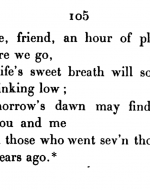Created by aman agah on Fri, 05/12/2023 - 15:35
Description:
To translate requires creativity and an openness to interpretation, as there are words and ideas which cannot be directly translated. Because of my bilingualism, despite knowing the limitations of my reading and written Farsi, I naively assumed this process would be much easier than it proved. I assumed I would go into Khayyam’s Farsi text with an ability to recognize the majority of the words, and only need the support of other texts and resources sparingly. I quickly learned that part of the openness and creativity of translation includes an ability to step back and recognize limitations, and work in collaboration - collaboration with other people and other texts.
In the case of Edward FitzGerald’s translation, his interpretation included an approach of utilizing Khayyam’s words and themes to inspire his own work, an approach leaning more heavily towards interpretation of ideas. I am approaching my own translation more in line with George Roe, thinking of interpretation as a method, as a tool used to best translate words and ideas, while attempting to be more true to Khayyam’s own word choices, and the themes Khayyam included inspired by his cultural, spiritual, and scholarly surroundings.
Because Khayyam’s work is so dense, and given my own limitations regarding Farsi, I am focusing on translating one stanza [Image 1]. In this image, from the Rubaiyat published by Learn Persian Online, the stanza is labeled as 14, in Farsi. Below Khayyam’s Farsi is the same stanza translated by FitzGerald. I want to note that this same stanza appears in FitzGerald’s text as number 20 [Image 2], and in Roe’s text as stanza 105 [Image 3]. As you can see in the first image, I began writing notes, including translating words I was already familiar with, a quote from my chair Dr. Shirazi that this stanza is in “harmony with Khayyam’s philosophy”, and a note to myself to also speak to my father, who is very well-versed in Iranian poetry.
My translation process involved re-writing the stanza in Farsi [Image 4], then writing the English translation of words beneath each Farsi word in another color of ink [Image 5]. Words that I was unsure of, I relied on a Farsi to English translation tool, as well as Dr. Shirazi and my father for support. Because Farsi is written and read right to left, the words in English appear jumbled. My process, which I chose to help me best untangle and interpret, was to first simply reverse the order of the English words, with a new ink color [Image 6]. From there, I then began to rearrange them in a way that best translates and interprets the stanza [Image 7].
A few points to note: “we won’t eat” should not be interpreted literally here. “Eat” is not always in reference to food, but can be applied as a verb in other context. For example, the expression in Farsi for “catch a cold” translates to “I have eaten cold”. So within the context of this stanza, “we won’t eat” refers back to “sorrow” - we are being called to not eat, or get stuck, in sorrow. The second word in the first stanza, “doost” can be translated as friend or lover, and in the case of this poem, I think that “beloved” will make the most sense.
The words I needed help with most from my father were “ghanimat”/”gift or prize”, “deer”/”convent”, and “saalegaan”/”the dead”. Convent, in this context, my father explained, is in reference to this mortal life as a sort of convent or cloister - I opted for a synonym of cloister, and went with “corridor”. This last word, “saalegaan”, was translated online as “seniors” or “elderly”, but with the help of my father I understand that in the context of the poem it speaks more directly about those who have died; and “saal” is the word for “year”, which connects back to the reference to “seven thousand”. Finally, my dad pointed out to me that “seven thousand” can also refer to “infinity”. Finally, “sar-beh-sareem” translates literally to “we are head-to-head”, and in the context of this line is referring to being in line with, or parallel to, those who have died before us. My final image [Image 8] is the completed translation by me. This was a laborious project, and one which I think I could work on for years to improve my interpretation of even this single stanza. But, it is also one which brought me joy, and allowed me to feel more connected to my language and culture.
Below I am including my translation, as well as those of Roe and FitzGerald for reference:
my translation:
“Oh beloved, come let us not linger in the sorrows
of tomorrow.
Let us consider this moment in life as a gift.
Tomorrow, let us pass through this mortal
corridor,
and we shall be among those who died
seven thousand years ago.”
Roe’s translation:
“Come friend, an hour of pleasure
ere we go,
For life’s sweet breath will soon be
sinking low;
To-morrow’s dawn may find both
you and me
With those who went sev’n thousand
years ago.”
FitzGerald’s translation:
“Ah, my Belovéd, fill the Cup that clears
TO-DAY of past regrets and future Fears—
To-morrow? - Why, to-morrow I may be
Myself with Yesterday’s Sev’n Thousand
Years.”







